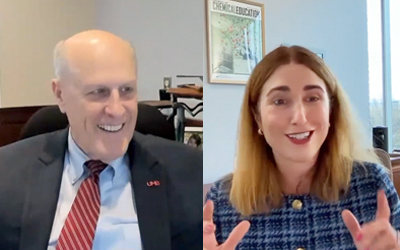Dean Sarah Michel Discusses the Future of Pharmacy Education, Research
April 03, 2024 Alex Likowski
On “Virtual Face to Face,” the dean talks with UMB President Bruce Jarrell about a number of topics including the challenges facing pharmacy schools and the profession in general.
The past few years have been tough ones for many pharmacists and pharmacy schools, made even harder by the demands of the COVID-19 pandemic. Many experienced Baby Boomers and even older Gen X pharmacists in the retail sector have called it quits or moved to less-demanding non-retail jobs. At the same time, enrollments in professional practice — PharmD — programs have plummeted at schools all over the country.
That’s a big change from just a few years ago. A Pharmacy Times headline in 2016 worried, “Are Pharmacy Schools Growing Too Fast?” The website noted that from 2005 to 2012, “a minimum of 4 new pharmacy schools opened each year” and several existing programs expanded.
And no wonder. The Baby Boom generation was headed for retirement, and the pharmacists’ scope of practice was continuing to expand into medication therapy management, monitoring chronic diseases, ordering and administering vaccines, and even prescribing medication.
And that demographic shift isn’t over. The World Bank recently predicted by 2050 1.5 billion people will be 65 or older, facing more chronic conditions than ever and likely no end to high health care and prescription costs and other barriers to care.
Analysts expect that will push the job market somewhat away from dispensing roles toward positions in health care settings and patient care-oriented roles like ambulatory care. The most recent Demand Report from the American Association of Colleges of Pharmacies (AACP) showed 61,000 job openings for pharmacists during the first three quarters of 2023, about 18 percent more than the previous year. Somewhat more than half of those were in the retail sector and about a third in clinical or hospital roles.
But as the number of available jobs continues to rise, pharmacy school enrollments are headed the other way. Ten years ago, the University of Maryland School of Pharmacy (UMSOP) had 635 spring semester PharmD students. Today, that number has fallen to 329. And it’s the same everywhere. AACP says the number of graduates from four-year pharmacy programs dropped from 14,223 in 2021 to 13,323 in 2022 — the largest single-year drop since 1983.
So, what’s the plan for attracting pharmacy students and preparing them for a changing future? That was the topic of the March 28 edition of Virtual Face to Face. Joining UMB President Bruce E. Jarrell, MD, FACS, was UMSOP Dean Sarah L.J. Michel, PhD.
Although Michel is in just her sixth month as UMSOP dean, she is in her 20th year as a member of the UMSOP faculty. During that time, she has served as chair of the Department of Pharmaceutical Sciences, associate dean for graduate programs, president of the Faculty Senate, interim dean after Dean Natalie Eddington, PhD, FAAPS, FCP, stepped down, and also is highly regarded as a pharmaceutical researcher.